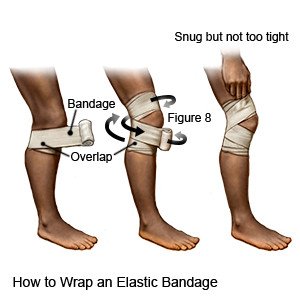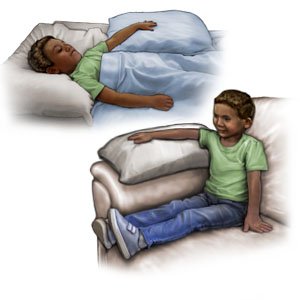Fasciotomy in Children
Medically reviewed by Drugs.com. Last updated on Aug 4, 2025.
AMBULATORY CARE:
What you need to know about a fasciotomy:
A fasciotomy is surgery to relieve pressure that is cutting off blood flow and nerve signals to muscles and tissues. Pressure builds under tissue called fascia that covers muscles and organs. The pressure may be caused by a crush injury, necrotizing fasciitis, or compartment syndrome. During a fasciotomy, an incision is made in the fascia. This helps relieve the pressure. A fasciotomy can be done on most areas of the body, but it is most common on the arm or leg.
How to prepare your child for a fasciotomy:
- Fasciotomy is often done as emergency surgery because pressure builds up suddenly. This means you might not have time to prepare your child. If you can prepare, your child's surgeon will tell you what to do. The surgeon may tell you not to let your child eat or drink anything before midnight on the day of surgery. You will be told which medicines your child can take or not take on the day of surgery. Tell your child's surgeon if your child has ever had problems with anesthesia.
- Your child may be given antibiotics to prevent a bacterial infection. Tell your child's surgeon if your child has ever had an allergic reaction to an antibiotic.
What will happen during a fasciotomy:
- Your child may be given general anesthesia to keep him or her asleep and free from pain during surgery. Depending on your child's age, he or she may instead be given regional anesthesia to numb the surgery area. Your child will be awake with regional anesthesia, but he or she should not feel pain. Your child's surgeon will make one or more incisions in the skin and fascia. This will relieve pressure that has built up in the area.
- Your child's surgeon may leave the incision open to let the pressure go down. This can take several days. A skin graft may be placed over the incision to protect the area until the pressure goes down. A skin graft is a piece of skin taken from another body area.
What will happen after a fasciotomy:
- Negative pressure wound therapy may be used before the incision is closed. A machine helps bring the edges of your child's skin closer together. Bacteria can also be removed with the machine.
- After the pressure goes down, the incision will be closed with stitches or staples. Strips of medical tape may be used to keep the edges of your child's skin together.
- The area may be wrapped with a compression bandage. You will be shown how to wrap the bandage to make sure it is not too tight. You should be able to fit 2 fingers between the bandage and your child's skin. You may need to remove and wrap the area regularly. Your child's healthcare provider will tell you how often to do this.

Risks of a fasciotomy:
Nerves may be damaged or destroyed near the surgery site. Your child may develop necrosis (tissue death). He or she will need more surgery to remove the tissue if this happens.
Seek care immediately if:
- Your child's stitches or staples come apart.
- Your child has bleeding from the surgery area that does not stop after 10 minutes of firm pressure.
- Your child cannot move the arm or leg that had the fasciotomy.
- Your child has signs of infection in the surgery area, such as red streaks, pus, or a foul odor.
- Your child has new or increased swelling in the surgery area.
Call your child's doctor or surgeon if:
- Your child has a fever.
- Your child has new or worsening pain in the surgery area.
- You have questions or concerns about your child's condition or care.
Medicines:
Your child may need any of the following:
- Antibiotics help fight or treat a bacterial infection.
- Pain medicine may be given. Do not wait until the pain is severe before you give your child his or her medicine.
- Do not give aspirin to children younger than 18 years. Your child could develop Reye syndrome if he or she has the flu or a fever and takes aspirin. Reye syndrome can cause life-threatening brain and liver damage. Check your child's medicine labels for aspirin or salicylates.
- Give your child's medicine as directed. Contact your child's healthcare provider if you think the medicine is not working as expected. Tell the provider if your child is allergic to any medicine. Keep a current list of the medicines, vitamins, and herbs your child takes. Include the amounts, and when, how, and why they are taken. Bring the list or the medicines in their containers to follow-up visits. Carry your child's medicine list with you in case of an emergency.
Wound care:
Look for signs of infection every time you care for your child's wound. Signs include red streaks, pus, and a foul-smelling discharge. Teach your older child to look for these signs every day.
- Wash your hands before and after you take care of the wound.

- Keep the bandage clean and dry. Do not stop using the bandage on the wound unless your child's healthcare provider says it is okay.
- Clean the wound and change the dressing as often as directed by your child's healthcare provider.
- If your child has strips of medical tape across the incision area, do not peel them off. They will fall off on their own in about 7 to 10 days. You can trim the edges as they start to peel to keep them from tearing.
- Apply firm, steady pressure to your child's wound if it bleeds. Use a clean towel or gauze.
Care for your child:
- Have your child rest as needed. Rest can help your child heal and prevent him or her from causing more damage to the surgery area. Try to have your child rest often during the day. Your adolescent may need to wait up to 3 weeks before he or she can drive. Ask when your child can return to normal activities. The time will depend on your child's age and why he or she had the fasciotomy. It will also depend on where the fasciotomy was done. Ask your child's healthcare provider when your child can start playing sports again.
- Elevate the area, if possible. If your child had a fasciotomy in an arm or leg, raise the area above the level of his or her heart as often as possible. Prop the area on pillows to keep it elevated comfortably. Elevation helps decrease swelling.

- Apply ice to the area as directed. Ice helps relieve pain and swelling, and may help prevent tissue damage. Use an ice pack, or put crushed ice in a plastic bag. Cover the pack or bag with a towel before you apply it to your child's skin. Apply ice for 15 to 20 minutes every hour, or as directed.
- Have your child bathe as directed. Your child may be able to take a shower about 2 days after surgery. Remove the bandage before the shower. Do not remove the tape strips covering the incision area. Pat the area dry with a clean towel after the shower. Wrap the incision area as directed after your child's skin is dry. Teach your older child how to shower safely. Show him or her how to wrap the bandage after the skin is dry. You should still check the bandage for your older child to make sure it is not too tight.
- Have your child use crutches if directed. If your child's fasciotomy was done on a leg, your child may need to use crutches until he or she heals. Crutches will help keep pressure off your leg. Ask your healthcare provider how long you need to use crutches.
- Offer your child a variety of healthy foods. Healthy foods give your child's body the nutrients it needs to heal the wound. Healthy foods include fruits, vegetables, grains (breads and cereals), dairy, and protein foods. Protein foods include meat, fish, nuts, and soy products. Protein, calories, vitamin C, and zinc help wounds heal. Ask for more information about the foods your child should eat to improve healing.

- Have your child drink more liquids. Liquids prevent dehydration that can decrease the blood supply to your child's wound. Ask your child's healthcare provider how much liquid your child needs to drink each day.
Take your child to physical or occupational therapy if directed:
A physical therapist can teach your child exercises to improve muscle strength and flexibility. An occupational therapist can teach your child how to do daily activities in a new way if needed. Physical and occupational therapy can help reduce pain and make movement easier.
Follow up with your child's doctor or surgeon as directed:
Write down your questions so you remember to ask them during your visits.
© Copyright Merative 2025 Information is for End User's use only and may not be sold, redistributed or otherwise used for commercial purposes.
The above information is an educational aid only. It is not intended as medical advice for individual conditions or treatments. Talk to your doctor, nurse or pharmacist before following any medical regimen to see if it is safe and effective for you.
Further information
Always consult your healthcare provider to ensure the information displayed on this page applies to your personal circumstances.
